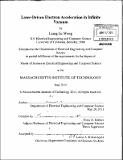Laser-driven electron acceleration in infinite vacuum
Author(s)
Wong, Liang Jie
DownloadFull printable version (7.646Mb)
Other Contributors
Massachusetts Institute of Technology. Dept. of Electrical Engineering and Computer Science.
Advisor
Franz X. Kartner.
Terms of use
Metadata
Show full item recordAbstract
I first review basic models for laser-plasma interaction that explain electron acceleration and beam confinement in plasma. Next, I discuss ponderomotive electron acceleration in infinite vacuum, showing that the transverse scattering angle of the accelerated electron may be kept small with a proper choice of parameters. I then analyze the direct (a.k.a. linear) acceleration of an electron in infinite vacuum by a pulsed radially-polarized laser beam, consequently demonstrating the possibility of accelerating an initially-relativistic electron in vacuum without the use of ponderomotive forces or any optical devices to terminate the laser field. As the Lawson-Woodward theorem has sometimes been cited to discount the possibility of net energy transfer from a laser pulse to a relativistic particle via linear acceleration in unbounded vacuum, I derive an analytical expression (which I verify with numerical simulation results) defining the regime where the Lawson-Woodward theorem in fact allows for this. Finally, I propose a two-color laser-driven direct acceleration scheme in vacuum that can achieve electron acceleration exceeding 90% of the one-color theoretical energy gain limit, over twice of what is possible with a one-color pulsed beam of equal total energy and pulse duration.
Description
Thesis (S.M.)--Massachusetts Institute of Technology, Dept. of Electrical Engineering and Computer Science, 2011. Cataloged from PDF version of thesis. Includes bibliographical references (p. 83-88).
Date issued
2011Department
Massachusetts Institute of Technology. Department of Electrical Engineering and Computer SciencePublisher
Massachusetts Institute of Technology
Keywords
Electrical Engineering and Computer Science.